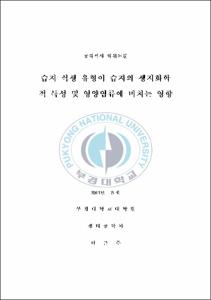습지 식생 유형이 습지의 생지화학적 특성 및 영양염류에 미치는 영향
- Alternative Title
- Effects of wetland vegetation type on wetland bigeochemical properties and nutrients
- Abstract
- Recently, the methods using the plants in wetlands have come into the spotlight as an ecological alternative which regulates nutrient removal from non-point source. However such researches are limited to emergent plants and the removal mechanisms for water pollutant by non-emergent plants in constructed wetlands are not clearly understood. Therefore, in order to understand the effects of biogeochemical properties on the nutrient behavior in the constructed wetland, in this study we have observed removal efficiencies of nutrients by various vegetation types at the artificially constructed microcosm for 5 days. Nutrients are better absorbed by Eichhornia crassipes which is one of the floating plants than by Ceratophyllum demersum in lower water temperature, DO, pH conditions, and The removal efficiency by Eichhornia crassipes was 60.66% in TN, 86.88% in TP. Ceratophyllum demersum which is one of the submerged plants supplied oxygens in the water by photosynthesis and promoted ammonification and nitrification reaction. The removal efficiency by Ceratophyllum demersum was 75.24% in TN, 88.44% in TP. Therefore we can confirm that findings of this study are used to select proper vegetation type for certain hydrology, climate, soil conditions when we design constructed wetland.
- Issued Date
- 2011
- Awarded Date
- 2011. 8
- Type
- Dissertation
- Keyword
- 습지 식물
- Publisher
- 부경대학교
- Alternative Author(s)
- Lee, Geun joo
- Affiliation
- 부경대학교
- Department
- 대학원 생태공학과
- Advisor
- 성기준
- Table Of Contents
- 목 차
Ⅰ. 서론 1
Ⅱ. 이론적 배경 3
1. 국·내외연구현황 3
2. 습지에서의 생지화학적 반응 및 영양염류 거동 5
가. 습지에서의 생지화학적 반응 5
나. 질소 거동 7
다. 인 거동 11
3. 부유식물 및 침수식물의 특성 13
가. 부유식물 13
나. 침수식물 14
Ⅲ. 재료 및 실험 방법 15
1. 실험 방법 15
가. mesocosm 설계 및 운영 15
나. 습지 식물 유형별 대표식물 선정 18
2. 분석방법 21
가. 수질분석 21
나. 저질분석 22
다. 식물분석 23
3. 통계분석 23
Ⅳ. 결과 및 고찰 24
1. 생지화학적 특성 24
가. 수온 변화 24
나. 용존산소농도 변화 28
다. 수소이온농도 변화 33
라. 산화환원전위 변화 36
(1) 물 36
(2) 토양 38
마. 영양염류 농도 변화 41
(1) 질소 41
(2) 인 62
바. 토양미생물활성도 76
사. 클로로필-a 78
아. 탁도 80
자. 생물량 변화 83
2. 습지에서의 질소 및 인 86
3. 고찰 95
Ⅴ. 결론 109
참고문헌 111
감사의 글 115
- Degree
- Master
- Files in This Item:
-
-
Download
 습지 식생 유형이 습지의 생지화학적 특성 및 영양염류에 미치는 영향.pdf
기타 데이터 / 4.37 MB / Adobe PDF
습지 식생 유형이 습지의 생지화학적 특성 및 영양염류에 미치는 영향.pdf
기타 데이터 / 4.37 MB / Adobe PDF
-
Items in Repository are protected by copyright, with all rights reserved, unless otherwise indicated.